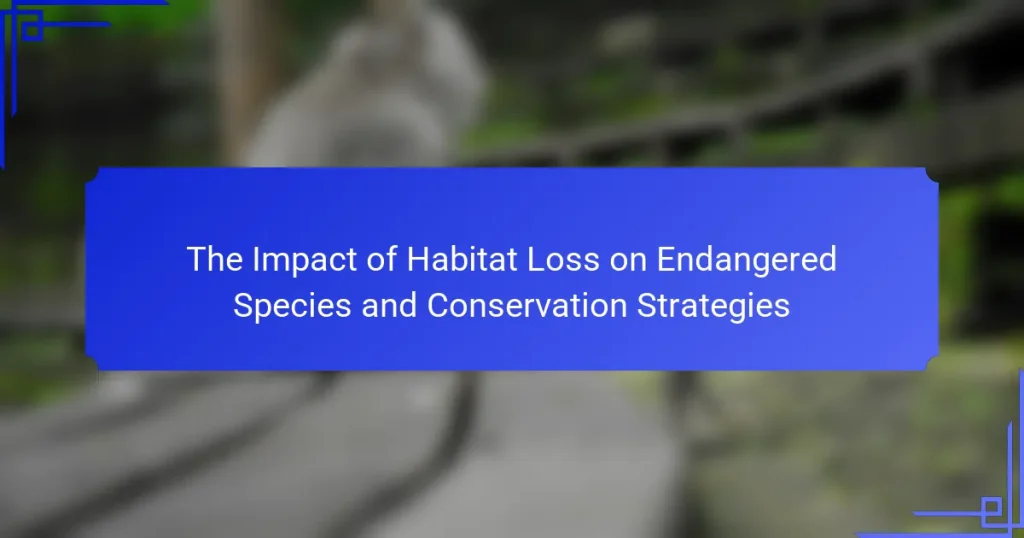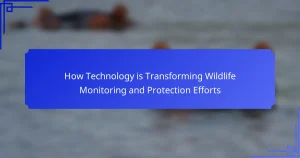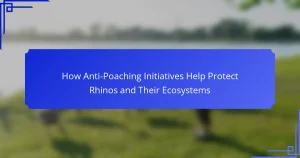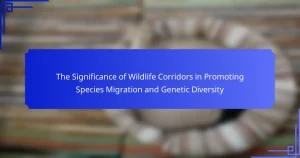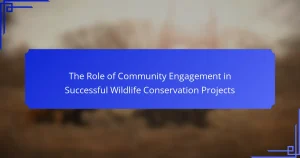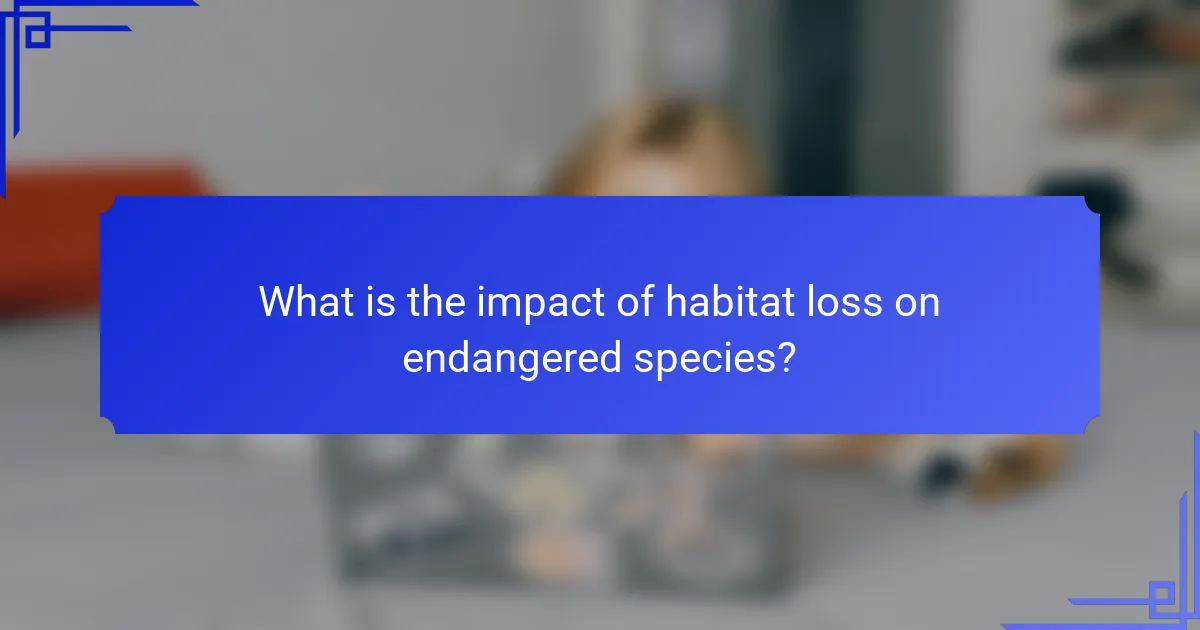
What is the impact of habitat loss on endangered species?
Habitat loss severely impacts endangered species by reducing their living space and resources. This leads to decreased populations and increased risk of extinction. Endangered species rely on specific habitats for food, shelter, and breeding. When these habitats are destroyed, their survival becomes threatened. For example, the destruction of forests for agriculture has led to the decline of species like the orangutan. Studies show that habitat loss is one of the primary drivers of species extinction globally. According to the International Union for Conservation of Nature (IUCN), around 80% of threatened species are affected by habitat loss.
How does habitat loss affect biodiversity?
Habitat loss significantly reduces biodiversity. It leads to the extinction of species that rely on specific environments. When habitats are destroyed, organisms lose their homes and resources. This disruption affects food chains and ecological balance. For instance, deforestation has caused a decline in species like the orangutan. Studies show that habitat loss is a primary driver of species extinction, with an estimated 1 million species at risk. Fragmented habitats also hinder species movement and reproduction. Overall, habitat loss diminishes genetic diversity, which is crucial for resilience.
What are the direct consequences of habitat loss on species survival?
Habitat loss directly threatens species survival by reducing their living space and resources. It leads to population decline as animals struggle to find food and shelter. Fragmented habitats make it difficult for species to reproduce and find mates. This isolation increases genetic inbreeding, weakening the population’s overall health. Many species face extinction when their habitat is destroyed or altered. According to the World Wildlife Fund, habitat loss is a primary driver of species extinction globally. Specific examples include deforestation impacting orangutans and the draining of wetlands threatening amphibians. These consequences highlight the urgent need for conservation efforts to protect remaining habitats.
How does habitat fragmentation contribute to the decline of species?
Habitat fragmentation contributes to the decline of species by isolating populations and reducing genetic diversity. When habitats are divided into smaller, disconnected patches, species may struggle to find mates. This isolation leads to inbreeding, which can weaken populations. Fragmented habitats also limit access to resources like food and shelter. For example, studies show that species in fragmented landscapes have lower survival rates. Additionally, smaller habitat patches support fewer individuals, making populations more vulnerable to extinction. Overall, habitat fragmentation disrupts ecological processes essential for species survival.
Why are certain species more vulnerable to habitat loss?
Certain species are more vulnerable to habitat loss due to their specialized habitat requirements. These species often rely on specific environments for food, shelter, and breeding. For instance, the California condor needs large areas of undisturbed land for nesting. Habitat fragmentation further isolates populations, making it harder for them to find mates and resources. Additionally, some species have limited ranges, meaning they cannot migrate to new areas when their habitat is destroyed. The IUCN Red List indicates that habitat loss is a primary threat to over 80% of species at risk of extinction. These factors collectively increase the susceptibility of certain species to habitat loss.
What characteristics make a species endangered?
Species are considered endangered when they face a high risk of extinction. Key characteristics include a significant decline in population size, often due to habitat loss, overexploitation, or environmental changes. Limited geographic range can also contribute, making them vulnerable to localized threats. Low reproductive rates and specific habitat requirements further increase their risk. For instance, the IUCN Red List categorizes species based on these criteria, indicating their conservation status. In 2021, over 28,000 species were listed as threatened, highlighting the urgency of conservation efforts.
How do ecological niches influence species vulnerability?
Ecological niches significantly influence species vulnerability by determining how species interact with their environment. Each species occupies a specific niche that includes its habitat, resource use, and role in the ecosystem. Changes in these niches, often due to habitat loss, can increase vulnerability. For instance, when habitats are altered, species may lose access to essential resources like food and shelter. This can lead to population declines and increased competition among remaining species. Studies show that specialized species with narrow niches are particularly at risk. They rely on specific conditions that may no longer exist due to habitat degradation. In contrast, generalist species can adapt more easily to changes, reducing their vulnerability. Thus, the stability of ecological niches is crucial for maintaining species resilience against environmental changes.
What are the primary causes of habitat loss?
The primary causes of habitat loss include deforestation, urbanization, agriculture, and climate change. Deforestation occurs when forests are cleared for timber or to make way for agricultural land. Urbanization leads to the expansion of cities, resulting in the destruction of natural habitats. Agriculture contributes significantly to habitat loss as land is converted for crop production and livestock grazing. Climate change alters ecosystems, affecting species’ habitats and their ability to survive. According to the World Wildlife Fund, approximately 1 million species are at risk of extinction due to habitat loss driven by these factors.
How does urbanization contribute to habitat destruction?
Urbanization contributes to habitat destruction by replacing natural landscapes with human-made environments. This process leads to the clearing of forests, wetlands, and grasslands. As cities expand, wildlife habitats are fragmented or entirely removed. Urban development often disrupts ecosystems and displaces native species. For example, the World Wildlife Fund reports that urban areas have increased by over 50% since 1990. This rapid expansion threatens biodiversity and increases the risk of extinction for many species. Urbanization also introduces pollution and invasive species, further degrading habitats. These factors collectively result in significant habitat loss and environmental degradation.
What role does agriculture play in habitat loss?
Agriculture plays a significant role in habitat loss. Agricultural expansion often leads to deforestation and land conversion. For instance, the Food and Agriculture Organization (FAO) reports that agriculture is responsible for about 80% of deforestation worldwide. This conversion reduces biodiversity and fragments ecosystems. Additionally, intensive farming practices degrade soil health and water resources. The loss of natural habitats impacts numerous species, leading to population declines and increased extinction risks. Studies indicate that agricultural practices threaten about 1 million species globally. Therefore, agriculture is a primary driver of habitat loss, significantly affecting conservation efforts.
How can conservation strategies mitigate the effects of habitat loss?
Conservation strategies can mitigate the effects of habitat loss by implementing protected areas and restoring ecosystems. Protected areas, like national parks, safeguard critical habitats from development and exploitation. These areas help maintain biodiversity and provide refuge for endangered species. Ecosystem restoration involves reforesting degraded lands and rehabilitating wetlands. This process enhances habitat quality and connectivity. Additionally, conservation strategies include sustainable land-use practices. These practices balance human needs with environmental protection. Research shows that effective conservation can lead to a 30% increase in species populations in restored habitats. By focusing on habitat preservation and restoration, conservation strategies directly address the root causes of habitat loss.
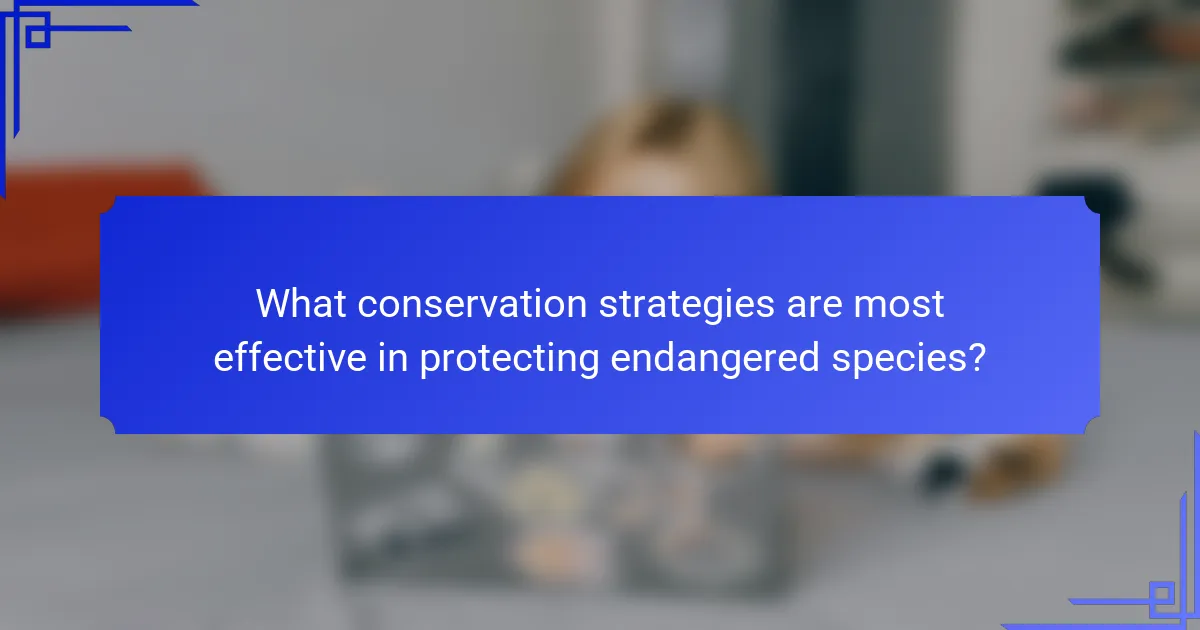
What conservation strategies are most effective in protecting endangered species?
Protected areas are among the most effective conservation strategies for protecting endangered species. These areas provide safe habitats free from human interference. Research shows that well-managed protected areas can increase species populations. For instance, the establishment of national parks has led to population recoveries in species like the gray wolf and the American bison. Conservation breeding programs also play a crucial role. They help increase the numbers of critically endangered species. For example, the California condor was brought back from the brink of extinction through such programs. Habitat restoration is another effective strategy. Restoring ecosystems can improve biodiversity and support endangered species. Reforestation efforts have successfully aided species like the orangutan in Indonesia. Furthermore, community engagement in conservation efforts enhances success rates. Local involvement fosters stewardship and sustainable practices. Overall, a combination of these strategies leads to more effective protection of endangered species.
What are the key approaches to habitat restoration?
Key approaches to habitat restoration include ecological restoration, reforestation, and wetland restoration. Ecological restoration focuses on returning an ecosystem to its original structure and function. This can involve removing invasive species and reintroducing native species. Reforestation involves planting trees in deforested areas to restore forest ecosystems. Studies show that reforestation can increase biodiversity and improve soil quality. Wetland restoration aims to restore the natural hydrology and vegetation of wetland areas. Successful wetland restoration can enhance water quality and provide habitat for diverse species. These approaches are essential for mitigating habitat loss and supporting endangered species conservation.
How does reforestation aid in species recovery?
Reforestation aids in species recovery by restoring natural habitats. It provides essential resources such as food and shelter for various species. This process helps to increase biodiversity in previously degraded areas. Studies show that reforestation can lead to population growth in endangered species. For example, the reintroduction of native trees in deforested regions has improved habitats for birds and mammals. Additionally, healthy forests can support complex ecosystems, which are crucial for species survival. Reforestation also mitigates climate change effects, further benefiting vulnerable species. Overall, restoring forests is a key strategy for enhancing species recovery efforts.
What role do protected areas play in conservation efforts?
Protected areas play a crucial role in conservation efforts by safeguarding biodiversity and ecosystems. They provide a refuge for endangered species, allowing populations to recover. Protected areas also help maintain ecological processes and support habitat integrity. According to the International Union for Conservation of Nature (IUCN), over 15% of the Earth’s land and 7% of the oceans are designated as protected areas. This designation reduces habitat loss and fragmentation, which are significant threats to species survival. Furthermore, protected areas contribute to climate change mitigation by preserving carbon sinks. They also promote sustainable practices that benefit local communities and enhance ecosystem services.
How can community involvement enhance conservation strategies?
Community involvement enhances conservation strategies by fostering local stewardship and increasing public awareness. Engaged communities are more likely to participate in conservation efforts. They can provide valuable local knowledge about ecosystems and species. This knowledge can inform better conservation practices. Community-led initiatives often receive greater support from residents. This support can lead to more sustainable funding and resources. Additionally, involving communities helps build a sense of ownership over local natural resources. Studies show that areas with active community participation have higher success rates in conservation outcomes. For example, the “Community-Based Conservation” approach has successfully restored habitats in various regions.
What are the benefits of local engagement in conservation projects?
Local engagement in conservation projects enhances effectiveness and sustainability. It fosters community ownership of conservation efforts. Engaged locals often possess invaluable traditional ecological knowledge. This knowledge can guide more effective conservation strategies. Collaborative efforts increase public awareness and support for conservation. Studies show that local involvement leads to better project outcomes. For example, a study by the World Resources Institute found that community-managed areas have higher biodiversity levels. Local engagement also promotes economic benefits through ecotourism and sustainable practices.
How can education and awareness programs impact conservation success?
Education and awareness programs significantly enhance conservation success. These programs inform communities about the importance of biodiversity and ecosystem health. Increased knowledge leads to greater public support for conservation initiatives. For instance, studies show that communities engaged in education programs are more likely to participate in conservation activities. Awareness campaigns can reduce harmful behaviors, such as poaching and habitat destruction. Research has demonstrated that informed individuals make better decisions regarding resource use. Furthermore, education fosters a sense of stewardship towards local environments. Ultimately, these programs create a more informed public that actively supports conservation efforts.
What role does legislation play in habitat conservation?
Legislation plays a crucial role in habitat conservation by establishing legal frameworks to protect ecosystems. It regulates land use and development to prevent habitat destruction. Laws such as the Endangered Species Act in the United States provide specific protections for threatened species and their habitats. These laws often require environmental impact assessments before development projects can proceed. They also create protected areas, such as national parks and wildlife refuges, to conserve critical habitats. Furthermore, legislation can impose penalties for violations, incentivizing compliance among businesses and individuals. Studies show that regions with strong conservation laws have better biodiversity outcomes. For example, the establishment of marine protected areas has led to the recovery of fish populations and marine ecosystems.
How do international treaties protect endangered species and their habitats?
International treaties protect endangered species and their habitats by establishing legal frameworks for conservation. These treaties, such as the Convention on International Trade in Endangered Species (CITES), regulate trade in endangered species. They promote habitat preservation through agreements that require countries to protect critical ecosystems. Additionally, treaties facilitate international cooperation for species recovery efforts. They often include provisions for funding and technical assistance to support conservation initiatives. For example, the Convention on Biological Diversity aims to ensure sustainable use of ecosystems. Countries that ratify these treaties commit to enacting laws that safeguard biodiversity. This legal commitment helps to enforce conservation measures and hold violators accountable.
What are the implications of local laws on conservation efforts?
Local laws significantly influence conservation efforts by determining the regulations and protections available for endangered species and habitats. These laws can establish protected areas and restrict activities that harm ecosystems. For instance, the Endangered Species Act in the United States provides legal frameworks to protect threatened species and their habitats. Local laws can also dictate land use, impacting habitat preservation and restoration initiatives. Compliance with these regulations is essential for successful conservation outcomes. In regions where local laws are weak or poorly enforced, habitat loss may accelerate, further endangering species. Conversely, strong local laws can enhance conservation efforts by promoting sustainable practices and habitat protection.
What innovative technologies are being used in conservation efforts?
Innovative technologies used in conservation efforts include drones, remote sensing, and artificial intelligence. Drones are utilized for aerial surveys and monitoring wildlife populations. Remote sensing technology helps track habitat changes and assess ecosystem health. Artificial intelligence analyzes large datasets to predict species behavior and identify threats. Genetic analysis aids in understanding biodiversity and species resilience. Camera traps provide real-time data on animal movements and population dynamics. Mobile applications engage citizen scientists in data collection and reporting. These technologies enhance conservation strategies and improve outcomes for endangered species.
How does remote sensing contribute to habitat monitoring?
Remote sensing significantly enhances habitat monitoring by providing detailed spatial data. It allows for the assessment of land cover changes over time. This technology uses satellite imagery to track vegetation health and distribution. Remote sensing can identify habitat fragmentation and degradation. It supports the analysis of ecological patterns and trends. Studies indicate that remote sensing improves the accuracy of biodiversity assessments. For instance, it can detect changes in habitat quality that affect endangered species. Overall, remote sensing is a critical tool for effective conservation strategies.
What role do drones play in conservation strategies?
Drones play a crucial role in conservation strategies by providing aerial monitoring and data collection. They enable researchers to survey large and inaccessible areas efficiently. Drones can track wildlife populations and monitor habitat changes over time. They also assist in anti-poaching efforts by providing real-time surveillance. Studies show that drones can reduce the costs of conservation operations significantly. For instance, a 2016 study published in “Conservation Biology” demonstrated that drone surveys were 80% cheaper than traditional methods. Furthermore, drones can capture high-resolution images for habitat mapping. This technology enhances the effectiveness of conservation interventions.
What can individuals do to support conservation efforts?
Individuals can support conservation efforts by participating in local clean-up events. These activities help remove litter from natural habitats. They can also volunteer with conservation organizations. This work aids in habitat restoration and monitoring wildlife. Additionally, individuals can reduce their carbon footprint. Using public transport or biking lessens greenhouse gas emissions. Supporting sustainable products promotes environmentally friendly practices. This encourages businesses to adopt better practices. Educating others about conservation raises awareness. Knowledgeable communities are more likely to engage in conservation actions. Lastly, donating to conservation charities provides essential funding for projects. Research indicates that community involvement significantly enhances conservation outcomes.
How can sustainable practices reduce habitat loss?
Sustainable practices can significantly reduce habitat loss by promoting resource conservation and minimizing environmental degradation. These practices include sustainable agriculture, which reduces deforestation and soil erosion. For example, agroforestry combines agriculture and forestry, preserving tree cover while producing food. Sustainable land-use planning prevents urban sprawl and protects natural habitats.
Additionally, renewable energy reduces reliance on fossil fuels, decreasing pollution and habitat destruction associated with mining and drilling. Conservation efforts, such as protected areas, help preserve critical ecosystems. According to the World Wildlife Fund, effective management of protected areas can sustain biodiversity and mitigate habitat loss.
Implementing these practices leads to healthier ecosystems, which support diverse species and reduce the risk of extinction.
The main entity of this article is habitat loss and its impact on endangered species. The article provides a comprehensive overview of how habitat loss reduces living space and resources, leading to population declines and increased extinction risks for various species. It discusses the primary causes of habitat loss, including deforestation, urbanization, and agriculture, and highlights the consequences for biodiversity and ecological balance. Furthermore, the article outlines effective conservation strategies, such as the establishment of protected areas and habitat restoration, to mitigate these impacts and support endangered species recovery.
